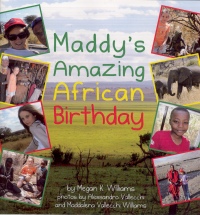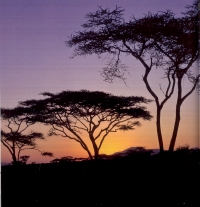| ________________
CM . . . . Volume XV Number 13. . . .February 20, 2009. 
 |
Maddy's Amazing African Birthday.
Megan K. Williams. Photos by Alessandro Vallecchi & Maddalena Vallecchi Williams.
Toronto, ON: Second Story Press, 2009.
32 pp., pbk., $12.95.
ISBN 978-1-897187-47-0.
Subject Heading:
Tanzanyia-Juvenile fiction.
Tanzanyia-Juvenile literature.
Grades 3-5 / Ages 8-10.
Review by Gail Hamilton.
***½/4
Reviewed from Advance Review Copy.
|
| |
|

excerpt:
A day I’ll never forget was when we visited the Hadzapi tribe. The Hadzapi are nomads too, except unlike the Maasai, they don’t build houses, or even tents. Instead, they sleep beside a campfire to keep warm and safe from animals.
The Hadzapi are famous for their incredible hunting skills. When we arrived, some boys were practicing shooting arrows at a log. Not one of them missed! The boys showed me how they put poison on the metal arrow tip so the animals die more quickly and don’t suffer. They’d already killed a monkey that day. Its insides were drying on a tree and they asked me if I’d wanted to try some. No thanks!
 Maddy gets the surprise of her life when her Uncle Alessandro, a photographer who travels the world, takes her on a two-week trip to Tanzania for her tenth birthday. Told from Maddy’s perspective (though authored by her mother), this true story documents Maddy’s and her uncle’s travels through Tanzania with their English-speaking African guide, Nimrod. The vacation begins with a game park safari during which Maddy sees a herd of elephants, a leopard (a rare sighting, according to her uncle), and several huge termite mounds. Other highlights include visits to a Maasai village and a Hadzapi tribe. At the Maasai village, Maddy sees, firsthand, how these nomadic people live, and she is impressed by their stick and cow dung homes, their beautiful beaded jewelry and their colorful clothing. She is amused by the children’s fascination with her hair. None of the children has ever seen long, straight hair before, and their curiosity compels them to want to touch it. From the Maasai village, Nimrod drives the pair to a lake filled with pink flamingos and then to a village where Maddy watches a woman grinding cassava root into flour on a large stone. Finally, they reach the Hadzapi tribe. After Maddy and her uncle try their hands at shooting with bows and arrows and learn how to make fire, they join the children for singing and dancing and making quill necklaces. On the last day of their vacation, they visit Nimrod’s house and meet his family, the only other English-speaking people they’ve encountered on their entire vacation. The family home is equipped with electricity, running water and a television, a far cry from the homes that Maddy has seen on the trip so far. At the end of the book, Maddy shares her gratitude for this amazing experience of a lifetime that inspires her to see more of the world one day. Maddy gets the surprise of her life when her Uncle Alessandro, a photographer who travels the world, takes her on a two-week trip to Tanzania for her tenth birthday. Told from Maddy’s perspective (though authored by her mother), this true story documents Maddy’s and her uncle’s travels through Tanzania with their English-speaking African guide, Nimrod. The vacation begins with a game park safari during which Maddy sees a herd of elephants, a leopard (a rare sighting, according to her uncle), and several huge termite mounds. Other highlights include visits to a Maasai village and a Hadzapi tribe. At the Maasai village, Maddy sees, firsthand, how these nomadic people live, and she is impressed by their stick and cow dung homes, their beautiful beaded jewelry and their colorful clothing. She is amused by the children’s fascination with her hair. None of the children has ever seen long, straight hair before, and their curiosity compels them to want to touch it. From the Maasai village, Nimrod drives the pair to a lake filled with pink flamingos and then to a village where Maddy watches a woman grinding cassava root into flour on a large stone. Finally, they reach the Hadzapi tribe. After Maddy and her uncle try their hands at shooting with bows and arrows and learn how to make fire, they join the children for singing and dancing and making quill necklaces. On the last day of their vacation, they visit Nimrod’s house and meet his family, the only other English-speaking people they’ve encountered on their entire vacation. The family home is equipped with electricity, running water and a television, a far cry from the homes that Maddy has seen on the trip so far. At the end of the book, Maddy shares her gratitude for this amazing experience of a lifetime that inspires her to see more of the world one day.
Telling the story in the first person is very effective in that it allows Maddy to share her feelings about what she is experiencing- from her sense of disappointment in the safari’s not meeting her expectations at first, to her sense of awe and wonder in seeing how other people live, and her compassion for the children whose parents cannot afford medicine for them. Sidebars with facts about various related topics- Swahili words, Maasai jewelry and elephants, for example- are included. Most of the colour photos were taken by Maddy and her uncle. Combined with the text, these photos almost make readers feel as if they, too, went along with Maddy on her vacation.
Highly Recommended.
Gail Hamilton is a teacher-librarian in Winnipeg, MB.

To comment on this title or this review, send mail to
cm@umanitoba.ca.
Copyright © the Manitoba Library Association. Reproduction for personal use is permitted only if this copyright notice is maintained. Any other reproduction is prohibited without permission.
NEXT REVIEW |
TABLE OF CONTENTS FOR THIS ISSUE- February 20, 2009.
AUTHORS |
TITLES |
MEDIA REVIEWS |
PROFILES |
BACK ISSUES |
SEARCH |
CMARCHIVE |
HOME |

 Maddy gets the surprise of her life when her Uncle Alessandro, a photographer who travels the world, takes her on a two-week trip to Tanzania for her tenth birthday. Told from Maddy’s perspective (though authored by her mother), this true story documents Maddy’s and her uncle’s travels through Tanzania with their English-speaking African guide, Nimrod. The vacation begins with a game park safari during which Maddy sees a herd of elephants, a leopard (a rare sighting, according to her uncle), and several huge termite mounds. Other highlights include visits to a Maasai village and a Hadzapi tribe. At the Maasai village, Maddy sees, firsthand, how these nomadic people live, and she is impressed by their stick and cow dung homes, their beautiful beaded jewelry and their colorful clothing. She is amused by the children’s fascination with her hair. None of the children has ever seen long, straight hair before, and their curiosity compels them to want to touch it. From the Maasai village, Nimrod drives the pair to a lake filled with pink flamingos and then to a village where Maddy watches a woman grinding cassava root into flour on a large stone. Finally, they reach the Hadzapi tribe. After Maddy and her uncle try their hands at shooting with bows and arrows and learn how to make fire, they join the children for singing and dancing and making quill necklaces. On the last day of their vacation, they visit Nimrod’s house and meet his family, the only other English-speaking people they’ve encountered on their entire vacation. The family home is equipped with electricity, running water and a television, a far cry from the homes that Maddy has seen on the trip so far. At the end of the book, Maddy shares her gratitude for this amazing experience of a lifetime that inspires her to see more of the world one day.
Maddy gets the surprise of her life when her Uncle Alessandro, a photographer who travels the world, takes her on a two-week trip to Tanzania for her tenth birthday. Told from Maddy’s perspective (though authored by her mother), this true story documents Maddy’s and her uncle’s travels through Tanzania with their English-speaking African guide, Nimrod. The vacation begins with a game park safari during which Maddy sees a herd of elephants, a leopard (a rare sighting, according to her uncle), and several huge termite mounds. Other highlights include visits to a Maasai village and a Hadzapi tribe. At the Maasai village, Maddy sees, firsthand, how these nomadic people live, and she is impressed by their stick and cow dung homes, their beautiful beaded jewelry and their colorful clothing. She is amused by the children’s fascination with her hair. None of the children has ever seen long, straight hair before, and their curiosity compels them to want to touch it. From the Maasai village, Nimrod drives the pair to a lake filled with pink flamingos and then to a village where Maddy watches a woman grinding cassava root into flour on a large stone. Finally, they reach the Hadzapi tribe. After Maddy and her uncle try their hands at shooting with bows and arrows and learn how to make fire, they join the children for singing and dancing and making quill necklaces. On the last day of their vacation, they visit Nimrod’s house and meet his family, the only other English-speaking people they’ve encountered on their entire vacation. The family home is equipped with electricity, running water and a television, a far cry from the homes that Maddy has seen on the trip so far. At the end of the book, Maddy shares her gratitude for this amazing experience of a lifetime that inspires her to see more of the world one day.